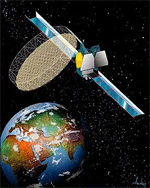 SEGMENTO SPAZIALE
SEGMENTO SPAZIALESegmento Spaziale
The Space Segment comprises one operational satellite (the Thuraya 2) positioned in Geosynchronous Orbit, 35,786 km (22,236 miles) above the Earth, at 44 degrees East Longitude and inclined at 6.3 degrees.
The first operational satellite was successfully launched on the 21st October 2000 and full commercial service began in a gradual roll out starting from April 2001 in many countries in Thuraya's coverage area. Thuraya's second satellite Thuraya 2 was launched on the 10th of June 2003 while a third satellite is being built by Boeing Satellite Systems to expand system capacity.
The Thuraya Geo satellite, which constitutes the Space Segment, is operated and managed by a sophisticated and integrated ground network known as the Ground Segment. The Ground Segment includes the Satellite Operation Centre, which monitors and controls satellite movement, ensuring the overall and ongoing maintenance of satellites in geo-synchronous orbit.
Satellite Overall Design
| •Number of satellites: 2 | •Service life of 12 years |
| •Type of orbit: Geo-synchronous orbit with 6.3° inclination | •Compatible with Sea Launch and Ariane 5 launch vehicles and others |
| •Orbital locations: 44° E and 28.5° E | •Supplier: Hughes Space & Communications International, Inc. |
Payload Subsystem
•12.25 meter aperture deployable satellite antenna |
•Solar Beginning of life 13KW End of life 11KW Panels are 2 wings of 4 panels each w/dual-junction gallium arsenide cells |
•On-board digital signal processing (DSP) to facilitate interconnectivity between the common feeder link coverage and the spot beams to make effective use of the feeder link band and to facilitate mobile to mobile links between any spot beams |
•Batteries 250 A-hr cells Dimensions |
•Digital beam-forming capability which allows Thuraya to reconfigure beams in the coverage area, to enlarge beams and to activate new beams. It also allows the system to maximise coverage of "hot spots", or those areas where excess capacity is required |
•In orbit L, solar arrays 34.5 m (113ft) W,antenna 17m (55.7 ft) |
•The flexibility to allocate 20% of the total power to any spot beam. |
•Stowed H:7.6m (25 ft) W:3.75m * 3.75m (12.3 ft) |
•The flexibility to reuse the spectrum up to 30 times and therefore use the spectrum efficiently. |
•Weights 5250 kg (11,576 lb) Launch 3200 kg (7,056 lb) In orbit (beginning of life) |
•The signal characteristics of 8 time-multiplexed voice circuits: Modulation pi/4 QPSK FDMA carrier channel BW 27.7 kHz Channel bit rate is 46.8kbps Bus Subsystem Power |
